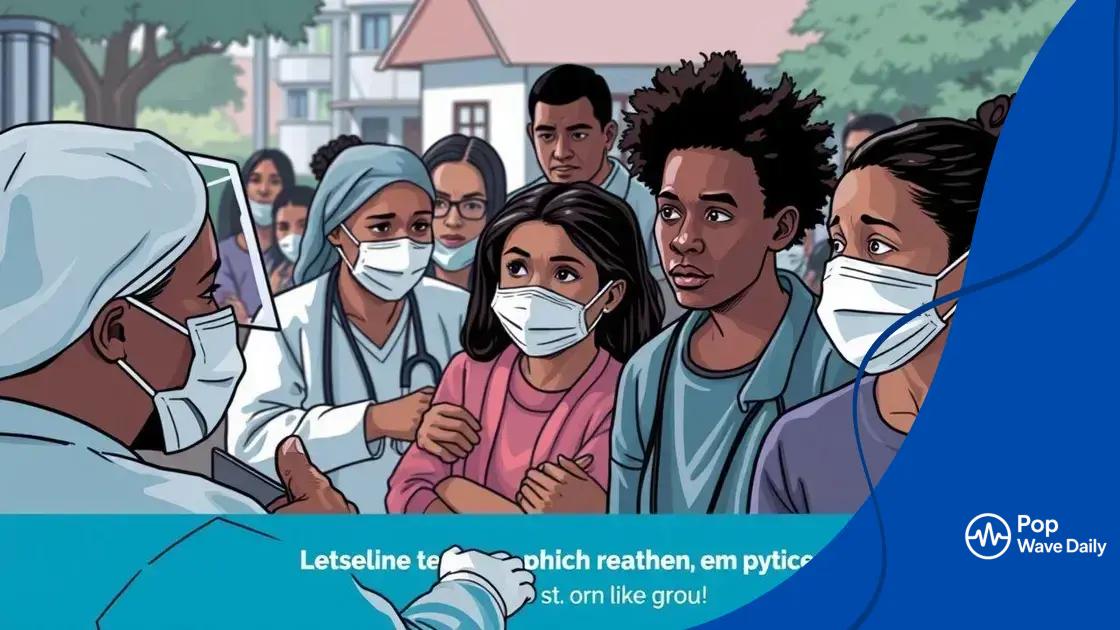Public health emergencies: understanding the impact

Anúncios
Public health emergencies arise from infectious diseases, natural disasters, and environmental hazards, necessitating effective preparedness strategies, community engagement, and robust communication to mitigate their impact on health systems.
Public health emergencies have the potential to change lives drastically. Have you ever considered how they ripple through our communities and health systems? This article explores the intricacies of these emergencies and ways to wise up for the future.
Anúncios
Defining public health emergencies
Understanding public health emergencies is crucial for ensuring the safety and wellbeing of communities. These emergencies occur when health threats arise, necessitating immediate attention and action.
There are various scenarios that can trigger a public health emergency. For instance, viral outbreaks, natural disasters, and environmental contamination can all pose significant health risks. Recognizing these situations early can help in coordinating effective responses.
Key Characteristics of Public Health Emergencies
A few distinguishing features define public health emergencies:
Anúncios
- They create a significant threat to health.
- They require rapid response to prevent or reduce morbidity and mortality.
- They often require coordination among multiple organizations.
Having a clear definition helps in creating response strategies tailored for various types of emergencies. In many cases, data collection and communication are essential for managing these situations effectively.
Community engagement is another critical aspect. When individuals understand what a public health emergency is, they are better equipped to participate in prevention and response efforts. For example, community drills can prepare people for various scenarios, ensuring a more resilient population.
Examples of Public Health Emergencies
Looking at actual cases can provide greater insight into the nature of these emergencies. Notable examples include:
- The COVID-19 pandemic, which required global coordination and rapid vaccine development.
- The Ebola outbreak, which highlighted the need for swift containment and treatment protocols.
- Hurricanes and other natural disasters that disrupt healthcare services and require emergency protocols.
In summary, defining public health emergencies involves understanding their characteristics, examples, and the need for readiness. These elements are crucial for effective response and recovery in any community faced with a health crisis.
Common causes and examples
There are several common causes that can lead to public health emergencies, each presenting unique challenges. Understanding these causes helps communities better prepare and respond.
A significant category of causes includes infectious diseases. For instance, outbreaks like influenza and COVID-19 can spread rapidly, impacting health systems globally. Outbreaks can occur due to various factors, such as increased travel and urbanization.
Environmental Factors
Another critical cause involves environmental factors. Situations like:
- Natural disasters (e.g., hurricanes, floods)
- Pollution events (e.g., toxic spills)
- Climate change, leading to new health risks
These events not only pose immediate risks but can also have long-term health effects on affected populations. For example, floods may lead to waterborne diseases, while air pollution can exacerbate respiratory problems.
Moreover, man-made events also contribute. Industrial accidents often lead to chemical exposures, while conflicts can strain health resources. Understanding these can aid in developing effective interventions.
Examples of Public Health Emergencies
Let’s look at some notable examples that illustrate these causes:
- The Ebola outbreak in West Africa demonstrated how infectious diseases could overwhelm health systems.
- The Flint water crisis showcased the impact of environmental factors on community health.
- Hurricane Katrina exposed vulnerabilities in healthcare infrastructure during natural disasters.
These examples stress the need for vigilant monitoring and preparedness. When communities can identify potential risks, they stand a better chance at mitigating the effects of a public health emergency.
Impact on communities and healthcare systems

The impact of public health emergencies on communities and healthcare systems is profound and multifaceted. Such events can disrupt daily life and strain medical resources, leading to significant challenges.
When a public health emergency occurs, communities often face immediate consequences. Fear and uncertainty spread, affecting mental health and well-being. People may avoid healthcare services due to worries about contagion or inadequate resources.
Strain on Healthcare Systems
Healthcare systems can quickly become overwhelmed during an emergency. This can manifest in various ways:
- Increased patient loads that exceed hospital capacity.
- Shortages of critical supplies like personal protective equipment (PPE) and medications.
- Health professionals facing burnout due to high demand and stressful conditions.
The response to emergencies must be rapid and efficient. Hospitals may implement triage systems to prioritize care based on urgency, affecting how patients are treated. Coordination between agencies becomes crucial to manage resources and establish effective response strategies.
Communities also need to adapt to new realities during a health crisis. Schools may close, events cancel, and people are advised to stay home. These changes can lead to social isolation and economic difficulties for many families, creating further challenges for mental health.
Long-term Effects
The long-term effects of public health emergencies can reshape communities in various ways. Once the immediate crisis passes, the repercussions may linger:
- Increased mental health issues stemming from stress and trauma.
- Economic repercussions that affect local businesses and employment rates.
- Health disparities that widen due to unequal access to resources during crises.
Recognizing these impacts helps inform future preparedness measures. Communities can learn from past events to strengthen resilience and improve their healthcare systems for potential future threats.
Strategies for effective response
Effective response strategies during public health emergencies are crucial for minimizing impact and protecting communities. These strategies ensure that resources are allocated appropriately and that communication is clear.
One vital aspect is preparedness planning. Communities must develop clear plans that outline procedures for various scenarios. These plans should include:
- Identifying key stakeholders and resources.
- Establishing communication channels for timely information sharing.
- Regular training and drills for responders and volunteers.
Training prepares individuals to act swiftly when emergencies occur. Familiarity with procedures builds confidence and efficiency, reducing confusion during crises. Collaborations across different sectors, such as healthcare, public safety, and community organizations, enhance the overall response capacity.
Rapid Assessment and Action
Rapid assessment of the situation is essential when a public health crisis emerges. This involves gathering data quickly to evaluate the scope of the emergency. Effective methods include:
- Using technology to track incidents in real-time.
- Conducting surveys to assess community needs.
- Leveraging existing health data for quick analysis.
With timely information, decision-makers can deploy resources where they are most needed. This data-driven approach ensures that interventions are appropriate and effective.
Community Engagement
Community engagement plays a pivotal role in crisis response. Providing information and support can empower individuals to take action. Communication should be clear and transparent, focusing on:
- Regular updates on the situation and guidance for the public.
- Resources available for those affected.
- Encouraging community participation in preparedness efforts.
When communities feel informed and involved, they are more likely to respond positively to health initiatives. Strong community ties can aid in mobilizing volunteers and resources quickly.
Future outlook and preparedness
Preparing for the future of public health emergencies requires foresight and adaptability. As the world changes, so do the challenges we face. Organizations and communities must continuously evolve their strategies to enhance resilience.
One key aspect of future preparedness is investing in technology. Emerging technologies can play a vital role in tracking diseases and managing responses. Using data analytics helps in predicting outbreaks and mobilizing resources swiftly. This means developing systems that allow for:
- Real-time data collection from multiple sources.
- Analysis of trends to anticipate health threats.
- Communication tools that keep the public informed and engaged.
Another essential factor is fostering strong partnerships. Collaboration between government agencies, healthcare providers, and community organizations can make responses more effective. Joint exercises and preparedness training can enhance teamwork, ensuring that everyone knows their role in an emergency.
Public Awareness and Education
Public awareness and education also play a significant role in future preparedness. It is important to have programs that inform people about public health risks and encourage proactive measures. Community education can include:
- Workshops on hygiene and prevention strategies.
- Training for volunteers and local leaders on emergency response.
- Outreach campaigns targeting at-risk populations.
By improving public understanding, communities can respond more effectively during crises. The involvement of informed citizens leads to quicker action and better cooperation with health authorities.
Adapting to Change
As we look forward, adaptability is crucial. The landscape of public health is constantly shifting, influenced by factors like climate change and global travel. Future strategies must remain flexible to respond to new challenges. This requires continuous assessment and innovation in public health policies to keep pace with emerging threats.
FAQ – Frequently Asked Questions about Public Health Emergencies
What are common causes of public health emergencies?
Common causes include infectious disease outbreaks, natural disasters, and environmental hazards that can threaten community health.
How can communities prepare for public health emergencies?
Communities can prepare by developing clear response plans, engaging in training drills, and investing in technology to enhance communication.
What role does community engagement play in emergency response?
Engaging the community builds awareness and empowers individuals to participate in health initiatives, making responses more effective.
What are some future strategies for public health preparedness?
Future strategies involve leveraging technology for tracking health data, fostering partnerships, and educating the public on health risks.